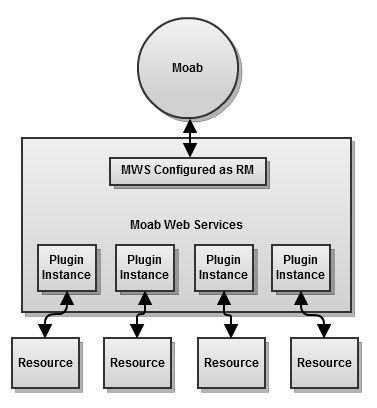5.293
Moab Web Services plugins provide a highly extensible interface to interact with Moab, MWS, and external resources. Plugins can perform some of the same functions as Moab resource managers (RMs), while also providing many other features not available to RMs. This section will discuss the main features of plugins, some basic terminology, and how MWS plugins can interact with Moab.
Features
Plugins can:
- Be created, modified, and deleted without restarting Moab Workload Manageror MWS.
- Be defined in Groovy and uploaded to MWS without restarting.
- Have individual data storage space and configuration.
- Access MWS configuration and RESTful web services.
- Log to a standard location configured in MWS.
- Be polled at a regular interval (configured on a per-plugin basis).
- Be informed of important system events.
- Be individually stopped, started, paused, and resumed.
- Expose secured and unsecured custom web services for external use.
- Be manipulated via a full RESTful API (for more information, see Resources Introduction).
- Be manipulated via a full user interface in a web browser.
Terminology
There are two distinct terms in the plugin layer: plugin types and plugins (instances).
Interactions with Moab as a resource manager
The plugin layer in MWS is integrated with Moab Workload Manager via the Native Resource Manager (RM) interface. When utilizing plugins, MWS is configured as a RM in Moab, as explained in the next section. Events from Moab are pushed through the RM interface to MWS, which is then pushed to each plugin in turn. The relationship between MWS, Moab, and plugins is shown in the following image:

For more information, see Data Consolidation and Reporting State Data.
Related Topics